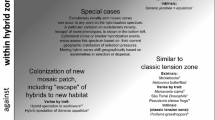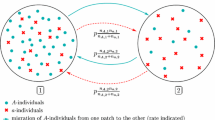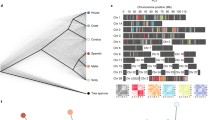Abstract
The assumption of low hybrid fitness serves as the cornerstone in the logical justification of the discreteness of species in terms of the biological concept. The majority of natural hybrid zones are narrow and stable in time; thus, this proves, as mathematical models have shown, the existence of selection against hybrids. It is assumed that, since the coadaptive gene complexes of the parent forms are destroyed in hybrids, they must be less viable and/or fertile. However, this statement remains no more than a hypothesis. The low reproductive success of hybrids may have other causes, e.g., they may have difficulties in pair formation because of the rarity and strangeness of their appearance. A computer simulation model has been constructed to verify this assumption. The main purpose of this work is to give answers to the following questions. (1) Is it possible to form a narrow and stable hybrid zone with assortative mating but without lower viability and fertility of the hybrids? Assortative mating in the model is due to sexual imprinting: descendants remember the image of one of their parents and seek an appropriate partner. (2) Is it possible to complete the speciation process under these conditions and what is necessary for this? Here, we interpret speciation as the process of the establishment of sympatry between the initially allopatric forms with the maintenance of their appearance and a low level of hybridization. The model study gave positive answers for both questions. Without biotopic segregation and with assortative mating, the hybrid zone is narrow and stable in time. Hybrids remain unmated more often than parent forms (5–8 and 1–3% respectively), which results in selection pressure in favor of a narrow hybrid zone. In addition to assortative mating, biotopic segregation is necessary to establish sympatry, and hybrids have to be less successful than parent forms in the occupation of an individual territory. In opposite case, when the biotopes of the both parent forms are optimal for hybrids, the contact zone became wider at first and then, after the smoothing of biotopic segregation, they started to slowly shrink to a narrow hybrid zone. As a result, the two forms became indistinguishable by selectively neutral loci (DNA markers analog) over the entire space of the model.


Similar content being viewed by others
REFERENCES
Alekseev, E.R., Chesnokova, O.V., and Kucher, T.V., Free Pascal i Lazarus: Uchebnik po programmirovaniyu (Free Pascal and Lazarus: Manual for Programmers), Moscow: DMK-Press, 2010.
Arnold, M.L., Natural Hybridization and Evolution, New York: Oxford Univ. Press, 1997.
Barton, N.H. and Hewitt, G.M., Analysis of hybrid zones, Annu. Rev. Ecol. Syst., 1985, vol. 16, pp. 113–148.
Butlin, R., Speciation by reinforcement, Trends Ecol. Evol., 1987, vol. 2, no. 1, pp. 8–13.
Chernetsov, N., Sokolov, L.V., Kosarev, V., Leoke, D., Markovets, M., et al., Sex-related natal dispersal of pied flycatchers: How far away from home? Condor, 2006, vol. 108, no. 3, pp. 711–717.
Coyne, J.A. and Orr, H.A., Speciation, Sunderland, MA: Sinauer, 2004.
Dobrzhanskii, F.G., Genetika i proiskhozhdenie vidov (Genetics and Species Origin), Moscow: Inst. Komp. Issled., 2010.
Grabovskii, V.I., Cellular automates as simple models of complex systems, Usp. Sovrem. Biol., 1995a, vol. 115, no. 4, pp. 412–418.
Grabovskii, V.I., Secondary contact areas: selection effects against hybrids, mating assortativeness, and competition, Zh. Obshch. Biol., 1995b, vol. 56, no. 3, pp. 291–309.
Grabovskii, V.I., Secondary contact areas: selection effects against hybrids, mating assortativeness, and competition, 2002. http://nature.air.ru/models/contact.htm.
Hewitt, G.M., Hybrid zones—natural laboratories for evolutionary studies, Trends Ecol. Evol., 1988, vol. 3, no. 7, pp. 158–167.
Kryukov, A.P. and Blinov, V.N., Interaction of the hooded crow (Corvus cornix L.) and carrion crow (C. corone L.) in the sympatry and hybridization zone: is there a selection against hybrids? Zh. Obshch. Biol., 1989, vol. 50, no. 1, pp. 128–135.
Lavrenchenko, L.A., Hybrid speciation in mammals: illusion or reality? Biol. Bull. Rev., 2014, vol. 4, no. 3, pp. 198–209.
Mayr, E., Animal Species and Evolution, Cambridge, MA: Harvard Univ. Press, 1963.
Orr, H.A., The population genetics of speciation: the evolution of hybrid incompatibilities, Genetics, 1995, vol. 139, no. 4, pp. 1805–1813.
Panov, E.N., Gibridizatsiya i etologicheskaya izolyatsiya u ptits (Hybridization and Ethological Isolation in Birds), Moscow: Nauka, 1989.
Poelstra, J.W., Vijay, N., Bossu, C.M., Lantz, H., Ryll, B., et al., The genomic landscape underlying phenotypic integrity in the face of gene flow in crows, Science, 2014, vol. 344, no. 6190, pp. 1410–1414.
Price, T.D., Speciation in Birds, Greenwood Village, CO: Roberts and Company, 2008.
Randler, C., Avian hybridization, mixed pairing and female choice, Anim. Behav., 2002, vol. 63, no. 1, pp. 103–119.
Randler, C., Mating patterns in avian hybrid zones—a meta-analysis and review, Ardea, 2008, vol. 96, no. 1, pp. 73–80.
Rubtsov, A.S., Reproductive isolation and definition of a species in birds, Zool. Zh., 2015, vol. 94, no. 7, pp. 816–831.
Ten Cate, C., Sexual imprinting, mate preferences and plumage evolution, Acta XX Congr. Int. Ornithologici, Wellington, 1991, pp. 1081–1088.
ACKNOWLEDGMENTS
The author expresses deep gratitude to V.I. Grabovskii for in-depth analysis of the work and valuable comments during preparation of the manuscript.
Funding
This study was supported by the Russian Foundation for Basic Research (project nos. 17-04-00903 and 18-04-00770).
Author information
Authors and Affiliations
Corresponding author
Ethics declarations
Conflict of interests. The authors declare that they have no conflicts of interest.
Statement on the welfare of animals. This article does not contain any studies involving animals performed by any of the authors.
Rights and permissions
About this article
Cite this article
Rubtsov, A.S. Computer Simulation Model of a Hybrid Zone: Assortative Mating in the Role of Selection against Hybrids. Biol Bull Rev 10, 186–192 (2020). https://doi.org/10.1134/S2079086420030068
Received:
Revised:
Accepted:
Published:
Issue Date:
DOI: https://doi.org/10.1134/S2079086420030068




